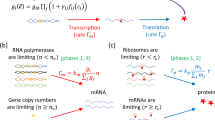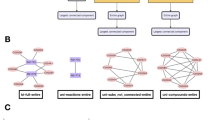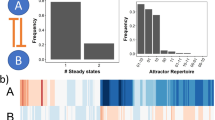Abstract
Network analysis has been applied widely, providing a unifying language to describe disparate systems ranging from social interactions to power grids. It has recently been used in molecular biology, but so far the resulting networks have only been analysed statically1,2,3,4,5,6,7,8. Here we present the dynamics of a biological network on a genomic scale, by integrating transcriptional regulatory information9,10,11 and gene-expression data12,13,14,15,16 for multiple conditions in Saccharomyces cerevisiae. We develop an approach for the statistical analysis of network dynamics, called SANDY, combining well-known global topological measures, local motifs and newly derived statistics. We uncover large changes in underlying network architecture that are unexpected given current viewpoints and random simulations. In response to diverse stimuli, transcription factors alter their interactions to varying degrees, thereby rewiring the network. A few transcription factors serve as permanent hubs, but most act transiently only during certain conditions. By studying sub-network structures, we show that environmental responses facilitate fast signal propagation (for example, with short regulatory cascades), whereas the cell cycle and sporulation direct temporal progression through multiple stages (for example, with highly inter-connected transcription factors). Indeed, to drive the latter processes forward, phase-specific transcription factors inter-regulate serially, and ubiquitously active transcription factors layer above them in a two-tiered hierarchy. We anticipate that many of the concepts presented here—particularly the large-scale topological changes and hub transience—will apply to other biological networks, including complex sub-systems in higher eukaryotes.
This is a preview of subscription content, access via your institution
Access options
Subscribe to this journal
Receive 51 print issues and online access
$199.00 per year
only $3.90 per issue
Buy this article
- Purchase on Springer Link
- Instant access to full article PDF
Prices may be subject to local taxes which are calculated during checkout



Similar content being viewed by others
References
Jeong, H., Tombor, B., Albert, R., Oltvai, Z. N. & Barabasi, A. L. The large-scale organization of metabolic networks. Nature 407, 651–654 (2000)
Guelzim, N., Bottani, S., Bourgine, P. & Kepes, F. Topological and causal structure of the yeast transcriptional regulatory network. Nature Genet. 31, 60–63 (2002)
Milo, R. et al. Network motifs: simple building blocks of complex networks. Science 298, 824–827 (2002)
Shen-Orr, S. S., Milo, R., Mangan, S. & Alon, U. Network motifs in the transcriptional regulation network of Escherichia coli. Nature Genet. 31, 64–68 (2002)
Oltvai, Z. N. & Barabasi, A. L. Systems biology. Life's complexity pyramid. Science 298, 763–764 (2002)
Barabasi, A. L. & Oltvai, Z. N. Network biology: understanding the cell's functional organization. Nature Rev. Genet. 5, 101–113 (2004)
Milo, R. et al. Superfamilies of evolved and designed networks. Science 303, 1538–1542 (2004)
Teichmann, S. A. & Babu, M. M. Gene regulatory network growth by duplication. Nature Genet. 36, 492–496 (2004)
Svetlov, V. V. & Cooper, T. G. Review: compilation and characteristics of dedicated transcription factors in Saccharomyces cerevisiae. Yeast 11, 1439–1484 (1995)
Horak, C. E. et al. Complex transcriptional circuitry at the G1/S transition in Saccharomyces cerevisiae. Genes Dev. 16, 3017–3033 (2002)
Lee, T. I. et al. Transcriptional regulatory networks in Saccharomyces cerevisiae. Science 298, 799–804 (2002)
DeRisi, J. L., Iyer, V. R. & Brown, P. O. Exploring the metabolic and genetic control of gene expression on a genomic scale. Science 278, 680–686 (1997)
Cho, R. J. et al. A genome-wide transcriptional analysis of the mitotic cell cycle. Mol. Cell 2, 65–73 (1998)
Chu, S. et al. The transcriptional program of sporulation in budding yeast. Science 282, 699–705 (1998)
Gasch, A. P. et al. Genomic expression programs in the response of yeast cells to environmental changes. Mol. Biol. Cell 11, 4241–4257 (2000)
Gasch, A. P. et al. Genomic expression responses to DNA-damaging agents and the regulatory role of the yeast ATR homolog Mec1p. Mol. Biol. Cell 12, 2987–3003 (2001)
Odom, D. T. et al. Control of pancreas and liver gene expression by HNF transcription factors. Science 303, 1378–1381 (2004)
Zeitlinger, J. et al. Program-specific distribution of a transcription factor dependent on partner transcription factor and MAPK signaling. Cell 113, 395–404 (2003)
Watts, D. J. & Strogatz, S. H. Collective dynamics of ‘small-world’ networks. Nature 393, 440–442 (1998)
Wagner, A. & Fell, D. A. The small world inside large metabolic networks. Proc. R. Soc. Lond. B 268, 1803–1810 (2001)
Yu, H., Greenbaum, D., Xin Lu, H., Zhu, X. & Gerstein, M. Genomic analysis of essentiality within protein networks. Trends Genet. 20, 227–231 (2004)
Martinez-Antonio, A. & Collado-Vides, J. Identifying global regulators in transcriptional regulatory networks in bacteria. Curr. Opin. Microbiol. 6, 82–489 (2003)
Madan Babu, M. & Teichmann, S. A. Evolution of transcription factors and the gene regulatory network in Escherichia coli. Nucleic Acids Res. 31, 1234–1244 (2003)
Pilpel, Y., Sudarsanam, P. & Church, G. M. Identifying regulatory networks by combinatorial analysis of promoter elements. Nature Genet. 29, 153–159 (2001)
Simon, I. et al. Serial regulation of transcriptional regulators in the yeast cell cycle. Cell 106, 697–708 (2001)
Ueda, H. R. et al. A transcription factor response element for gene expression during circadian night. Nature 418, 534–539 (2002)
Yu, H., Zhu, X., Greenbaum, D., Karro, J. & Gerstein, M. TopNet: a tool for comparing biological sub-networks, correlating protein properties with topological statistics. Nucleic Acids Res. 32, 328–337 (2004)
Christie, K. R. et al. Saccharomyces Genome Database (SGD) provides tools to identify and analyze sequences from Saccharomyces cerevisiae and related sequences from other organisms. Nucleic Acids Res. 32, D311–D314 (2004)
Acknowledgements
We thank P. Bertone, N. Domedel-Puig, E. Hovig, R. Jansen, K. Kleivi, G. Koentges, E. Koonin, B. Lenhard, A. Paccanaro, J. Rozowsky, J. Tegner, V. Trifonov, A. Todd, Y. Xia and H. Zao for comments on the paper. N.M.L. thanks the Anna Fuller Fund and the MRC LMB Visitor's Program. M.M.B. acknowledges financial support from the Cambridge Commonwealth Trust, Trinity College, Cambridge and the MRC LMB. M.G. is supported by the NSF and NIH.
Author information
Authors and Affiliations
Corresponding authors
Ethics declarations
Competing interests
The authors declare that they have no competing financial interests.
Supplementary information
Supplementary Material
New Text: Subheadings 1-8, including 2 figures (PDF 573 kb)
Rights and permissions
About this article
Cite this article
Luscombe, N., Madan Babu, M., Yu, H. et al. Genomic analysis of regulatory network dynamics reveals large topological changes. Nature 431, 308–312 (2004). https://doi.org/10.1038/nature02782
Received:
Accepted:
Issue Date:
DOI: https://doi.org/10.1038/nature02782
This article is cited by
-
An Encrypted Proposal Method in Membrane Computing Aggregation (MCA)
Mobile Networks and Applications (2023)
-
A novel approach GRNTSTE to reconstruct gene regulatory interactions applied to a case study for rat pineal rhythm gene
Scientific Reports (2022)
-
Temporal assessment of lesion morphology on radiological images beyond lesion volumes—a proof-of-principle study
European Radiology (2022)
-
Integrative inference of transcriptional networks in Arabidopsis yields novel ROS signalling regulators
Nature Plants (2021)
-
Internetwork connectivity of molecular networks across species of life
Scientific Reports (2021)
Comments
By submitting a comment you agree to abide by our Terms and Community Guidelines. If you find something abusive or that does not comply with our terms or guidelines please flag it as inappropriate.



